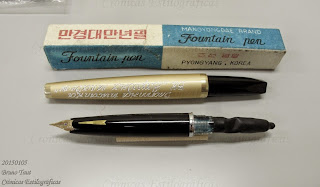Then, on the other hand, there was a wealthy mixture of names associated to these pens. Nikko Ebonite is the name of the mother company; then there was the name Eboya for its online shop. Finally, Nebotek was the pen brand.
All this changed when around January 2014 the company decided, first, to forget about the name Nebotek; and, second, to sign the pens. These pens are now named Eboya, with the lemma “Made in Tokyo” under it, as can be seen on the photography accompanying this text.
Eboya’s marketing problems do not finish here. Eboya pens lack visibility in the market, and they rely solely on their website, which is only written in Japanese. This also might be changing. To start, Eboya pens are now going to be distributed in the US –and beyond— through John Mottishaw’s website Nibs.com. In fact, the first fifteen Eboya pens have just been shipped to the US, according to Eboya nibmeister Kanesaki.
Nikko Ebonite is a small company, and Eboya pens are in essence the product of one man alone, Mr. Noritoshi Kanesaki. Their limited resources might be at the bottom of their precarious marketing, but they could do better as many other small operations in the world of fountain pens are showing.
Pilot Custom 912, music nib – Sailor Yama-dori
Bruno Taut
Nakano, February 25th, 2014
etiquetas: Eboya, Nebotek, mercado, Kanesaki Noritoshi
Bruno Taut
Nakano, February 25th, 2014
etiquetas: Eboya, Nebotek, mercado, Kanesaki Noritoshi





































